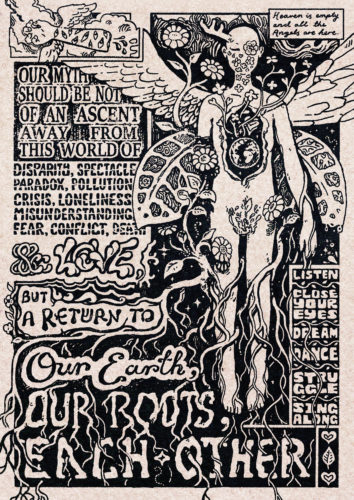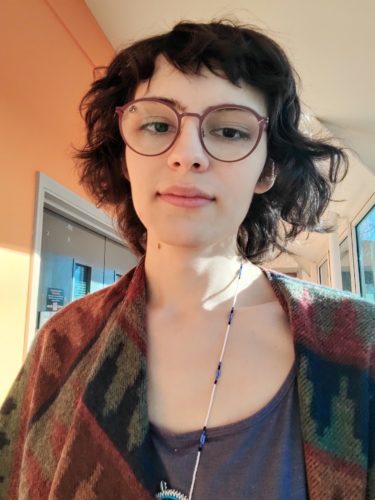“Our myth should be not of an ascent
away from this world of disparity, spectacle, paradox, pollution, crisis, loneliness, misunderstanding, conflict, death, and Love
But a return to our Earth,
our Roots, Each Other.
Listen. Close your eyes. Dream. Struggle. Sing along;
Heaven is empty and all the angels are here.”
It seems now more than ever that we are faced with crises upon crises: looming climate catastrophe, rising fascism, racism and transphobia, political and social alienation, a mental health epidemic and ever-growing wealth inequality.
In the palms of our hands, we have access to endless headlines detailing vast ecological and national tragedies. It can seem mind-numbingly obvious that there should be a widespread response from peoples and governments across the globe, yet, save for the occasional march or petition, we remain almost entirely powerless. The result is an overwhelming isolation, panic and paralysis when facing the blues of existential dread.
The ratio of information we’re provided with is completely disproportionate to our ability to act on that same information. Human brains and bodies did not evolve to emotionally regulate that level of disparity, and for anyone who finds themselves wishing for a brighter future, the resulting psychological implications are deeply concerning.
This piece, Heaven is empty and all the Angels are here, is the culmination of my final major project for an illustration degree. Throughout it I sought to tie together themes of mythology, mental health, ecology and activism.
My research would repeatedly lead me into encounters with a spectrum of contemporary authors, each addressing our crises with an encouraging expertise, wisdom and grace. Disparate disciplines were joined by similar threads, and the process rewilded my tired and fearful mind with a rich compost of ideas from which to draw.
Related reads
The project itself began by looking at my own mythologies as a transgender woman, analysing the way I would repeatedly identify with angelic symbols as a means to “ascend” away from the distress that came with being feared and aggressively scapegoated in conservative narratives about my “illegitimate” identity and body.
Be not afraid, I would caption my drawings of angels that blurred the line between divinity and monstrosity, with reference to words often spoken by angels throughout the Bible. These winged bodies would often be in the process of vivisection, open and vulnerable in a plea for empathy from the viewer. This imagery spilled out of me especially in the wake of the murder of Brianna Ghey, a trans sister of 16 years.
In one of the chapters of her book The Flowering Wand, eco-feminist and mythologist Sophie Strand explores the historical context of Gnosticism, and the way the violent persecution of early Christians and Jews might have formed mystic practices that sought to condemn and escape the cruel failings of the material world. She links this to the psychology of detachment and trauma responses:
We cut our minds off from the suffering of our bodies as an escape mechanism. This instinctive response protects people who are undergoing unimaginable violence. But when it becomes embedded in the nervous system, the disconnect can cause physical and psychological distress. (The Flowering Wand, p.126)
While I don’t seek to equate transgender mythologies to that extreme, the parallels were clear enough to begin to understand that the impulse toward “ascension,” or any other escapism, is not limited to any single group, but is instead to be found wherever there is fear or pain.
Author and physician Gabor Mate explores the same process of emotional disruption and its implications thoroughly in his book The Myth of Normal, and continues on to investigate means for healing our fraught connection to our bodies and emotions. He writes:
Any movement toward wholeness begins with the acknowledgment of our own suffering, and of the suffering in the world. This doesn’t mean getting caught in a never-ending vortex of pain, melancholy, and, especially, victimhood; … True healing simply means opening ourselves to the truth of our lives, past and present, as plainly and objectively as we can. (The Myth of Normal, p.296-297)
It is from this idea of healing that all these pieces began to fall into place for me. Our crises are all of disconnection: from ourselves, from our planet, and from each other.
In his beautiful and moving book Human Kind, historian Rutger Bregman thoroughly tests the historic and scientific legitimacy of our pervasive mistrust of others. He uncovers how our cynical view of human nature is itself a kind of trauma response, the twisted mirror image of a “placebo” effect – a self-fulfilling prophecy that denies us the faith in one another required to heal our communities and tend to our crises.
Likewise, in her books Braiding Sweetgrass and The Democracy of Species, Robin Wall Kimmerer, a professor of ecology, brings to light the cultural and structural disconnect we have from planet Earth and its ecosystems. She juxtaposes these epidemics of alienation and extraction with a radically differing mindset owed to Indigenous stewardship. This framing, both new and old, hands us an alternative understanding of our relationship with the world that recenters a gratitude, reciprocity and sustainability rooted in science, poetry and mythologies of animism and animacy.

The poster attempts to bring these ideas together and advocate for an alternate path. Instead of soaring away from our bodies and our world on imagined wings, we can plunge our feet and roots into the soil, trading in our extractive mindsets for a reciprocal relationship with the Earth, fellow humans and our own minds.
I propose the soil as a nested symbol and metaphor for this process. Soil is a reservoir of nourishment to which we are bound inextricably, and when we refuse to cooperate and give back to the soil, its essential nutrients dry out. It represents those vital substrates that we must conserve and replenish in order to survive: our mental health, our communities and our planet. When we return to the soil, we are refusing to perpetuate our chronic disconnection and neglect.
My activism since completing this project has felt much more human, centring trust and goodwill in order to foster mutual solidarity, education and action, both locally and online.
In these times of distress and detachment, class consciousness and ecological consciousness cannot survive and thrive in the absence of community consciousness. It is through mutual joy, rest and companionship that we find the emotional resilience needed to confront the psychological impacts of crises. Our need for kinship and camaraderie is no accident, but an evolved human impulse for collaboration.
The deep fulfilment we find in connecting with fellow humans and our planet is no accident in homo sapiens evolution – it’s as natural to our survival as the sensation of hunger is to our need for food.
We don’t have to look elsewhere; everything we need is right here. It’s in the people around us and the ground beneath our feet.

To follow Emma Lesur’s work or contact her, please visit her website and see what she’s up to on Instagram and Twitter @gremwyn.








